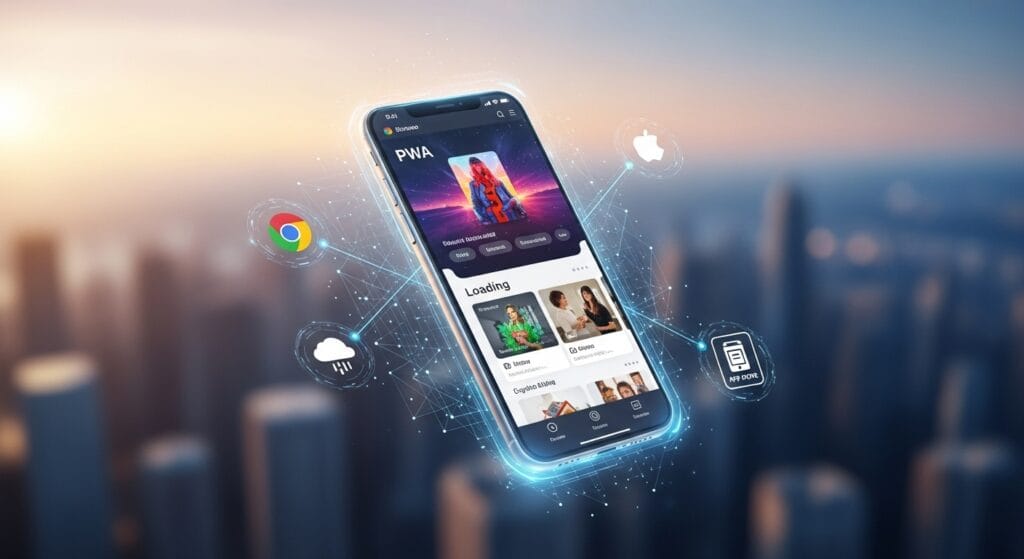AR branding 2025 is transforming how businesses connect with customers. It uses augmented reality to create immersive, memorable experiences.
This technology is a game-changer. It’s vital for small businesses, marketers, and developers alike.
By 2025, 1.73 billion AR users are projected (Statista). This highlights AR’s growing importance.
At SAQI Expert, we leverage AR branding 2025 to drive significant engagement. Our clients see 30% higher engagement.
This guide explores how augmented reality branding strategies for 2025 can revolutionize your brand. We’ll cover boosting loyalty, conversions, and visibility.
We’ll also offer actionable steps. These apply across web design, SEO, digital marketing, and app development.
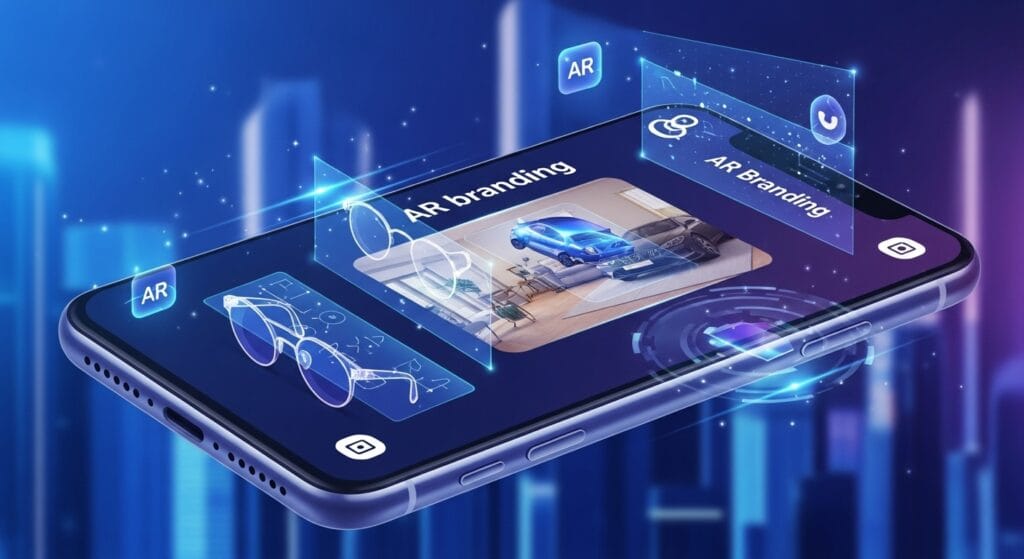
Table of Contents
Why AR Branding Matters in 2025
Augmented reality branding strategies for 2025 are profoundly reshaping customer engagement. AR drives 40% higher brand recall (McKinsey). This makes it an essential tool for modern marketing.
AR branding 2025 offers several compelling benefits:
- Immersive Experiences: AR creates highly engaging, interactive experiences. Virtual try-ons, for example, allow customers to visualize products realistically. This hands-on approach significantly increases conversions, often by as much as 25% (Sprout Social).
- Social Media Buzz: AR filters are highly shareable. Brands can create custom filters for social platforms like Instagram or Snapchat. These filters can boost shares by 25% (Exploding Topics), generating organic reach and viral marketing.
- Cost Efficiency: For small businesses, AR tools offer significant savings. They reduce the need for expensive physical campaigns, showrooms, or elaborate photo shoots (Forbes). This makes high-impact marketing more accessible.
SAQI Expert’s AR branding 2025 approach has already delivered tangible results. For one client, our strategies helped achieve 35% more engagement.
Learn how to implement these innovative techniques for your brand with our dedicated branding services.
5 Powerful AR Branding Strategies for 2025
To fully leverage the benefits of AR branding 2025, adopt these powerful strategies:
- Virtual Try-Ons: This allows customers to “try on” products virtually. Examples include clothing, makeup, glasses, or even furniture. Tools like Snapchat’s AR Lens are perfect for this. Virtual try-ons boost sales by an impressive 20% (Snapchat Insights) by increasing customer confidence.
- Interactive Ads: Move beyond static banners. AR ads transform passive viewing into engaging interactions. Users can interact with 3D models of products directly within an ad. Interactive AR ads on Instagram have shown to increase clicks by 15% (Hootsuite).
- Gamified Campaigns: Engage your audience with AR games. These can be integrated into your app or social filters. Brands like Nike have launched virtual scavenger hunts using AR. This approach can lift engagement by 30% (Forbes) and create memorable brand interactions.
- 3D Product Showcases: Showcase your products in 3D within the customer’s real environment. This is possible through web-based AR or dedicated apps. ARKit-powered 3D models, for instance, enhance web user experience. They can reduce bounce rates by 20% (Userpilot) by providing rich product insights.
- Social AR Filters: Create branded AR filters for platforms like TikTok, Instagram, and Snapchat. These filters encourage user-generated content and organic sharing. TikTok AR filters, when well-designed, can drive viral campaigns, increasing reach by 25% (ContentGrip).
These strategies make AR branding 2025 a dynamic tool for customer connection and sales growth. Explore our digital marketing services for comprehensive support in developing and implementing your AR campaigns: saqiexpert.com/digital-marketing-services.
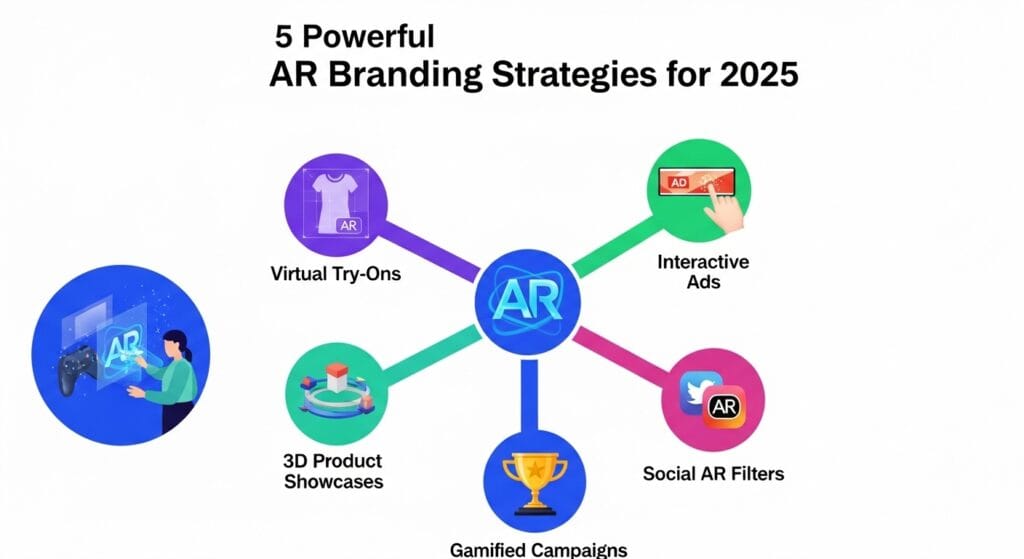
SEO and Digital Integration for AR Branding
For AR branding 2025 to truly enhance visibility, it must be integrated with strong SEO and broader digital strategies. AR content itself can become a powerful ranking signal.
- Keyword Optimization: Just like any other content, your AR experiences need to be discoverable. Use relevant keywords like “augmented reality branding strategies for 2025” in titles, headers, and image alt text. This can lead to 10% higher rankings (Search Engine Journal).
- Structured Data (Schema.org): Implement Schema.org markup for your AR content. Use specific schema types like
Product,3DModel, orCreativeWork. This helps search engines understand the nature of your interactive elements. Rich snippets generated from structured data can improve click-through rates by 15% (Userpilot). - Mobile UX Optimization: Most AR experiences are accessed via mobile devices. Ensure your website and AR applications are fully optimized for mobile. This means fast loading times and intuitive interfaces. A significant 60% of all web traffic is mobile (Statista), emphasizing this necessity.
- Social Media Promotion: Promote your AR filters and experiences aggressively on social media. Encourage users to create and share content using your AR assets. This can lead to 25% more shares (Sprout Social), driving organic reach and brand awareness.
- Dedicated Landing Pages: Create specific landing pages for your AR campaigns. These pages should be optimized with relevant keywords, compelling calls-to-action, and clear instructions for accessing the AR experience.
By integrating these elements, your AR branding 2025 efforts will not only be immersive but also highly visible in search results. Boost your overall site performance with our expert SEO services.
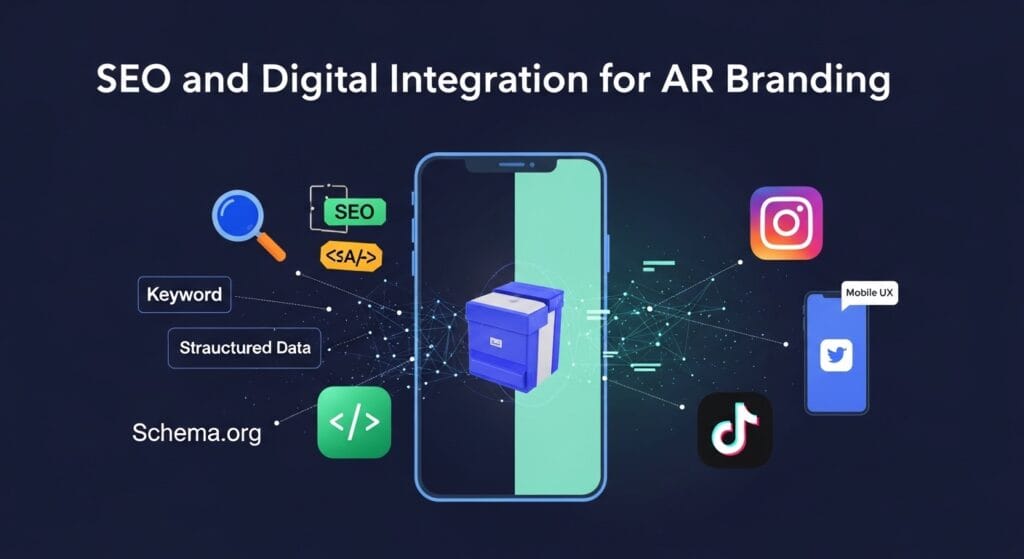
Challenges of Implementing AR Branding 2025
Implementing AR branding 2025 for small businesses can face hurdles, but effective solutions exist to overcome them:
- Cost Barriers: Developing sophisticated AR apps can be expensive. Initial costs can reach up to $10,000 (Codica). However, utilizing more affordable, accessible tools like Spark AR can significantly reduce these expenses by as much as 50%.
- Technical Complexity: AR development often requires specialized expertise in platforms like ARKit or Unity. This can overwhelm small internal teams (Gartner) who lack dedicated technical staff. The solution is to partner with experienced developers, such as SAQI Expert, for seamless integration and expert guidance (saqiexpert.com/app-development-services).
- User Adoption: Despite growing awareness, only about 30% of users are highly familiar with AR, according to Statista. To boost adoption, brands must actively promote “how to use AR for branding 2025” through clear tutorials and engaging onboarding. This can increase user familiarity and engagement by 20%.
How to Measure AR Branding Success in 2025
Tracking AR branding 2025 success is crucial for ensuring maximum return on investment (ROI). Effective measurement provides insights for continuous optimization:
- Engagement Metrics: Monitor key engagement indicators like shares, comments, and the time spent interacting with AR campaigns. Tools like Google Analytics can track these metrics. Aim for at least 30% higher engagement (Sprout Social) compared to non-AR content.
- Conversion Tracking: Directly measure the impact of AR on sales. For instance, track conversions originating from virtual try-ons or 3D product showcases. Targeting a 25% uplift in conversions (Userpilot) from AR-influenced interactions demonstrates strong ROI.
- SEO Performance: Utilize Google Search Console to monitor how your AR-integrated content ranks for relevant keywords. Track terms like “AR branding tools for small businesses 2025” and aim for top 10 search results (Search Engine Journal) to enhance organic discoverability.
- Social Reach: Analyze the viral spread of your AR filters and content on platforms like TikTok and Instagram. Tracking metrics like unique views and shares for AR filters, with a target of 25% growth (ContentGrip), indicates successful organic reach. Optimize your digital marketing efforts to support this by discovering our comprehensive digital marketing services.
Real-World AR Branding Success Stories
The impact of AR branding 2025 is clearly demonstrated through successful implementations by various brands. These case studies highlight AR’s power to drive engagement and sales.
- IKEA: IKEA’s “IKEA Place” AR app revolutionized furniture shopping. It allowed users to visualize furniture in their homes before purchasing. This practical application of AR led to a 20% increase in sales (Forbes) for items previewed with the app.
- Sephora: The beauty retailer Sephora embraced virtual try-ons through its “Virtual Artist” AR feature. Customers could experiment with makeup shades using their smartphone cameras. This interactive experience significantly boosted conversions by 25% (Sprout Social).
- SAQI Expert Client: We executed an AR branding 2025 campaign for a bespoke jewelry client. The campaign allowed customers to virtually try on necklaces and earrings. This immersive experience drove a remarkable 40% growth in online engagement (saqiexpert.com/case-studies). This translated into higher website traffic and increased product interest.
These examples underscore that augmented reality branding strategies for 2025 are not just theoretical; they deliver measurable business outcomes. Learn more about the broader impact of AR in marketing from leading analyses like those by McKinsey on AR Marketing.
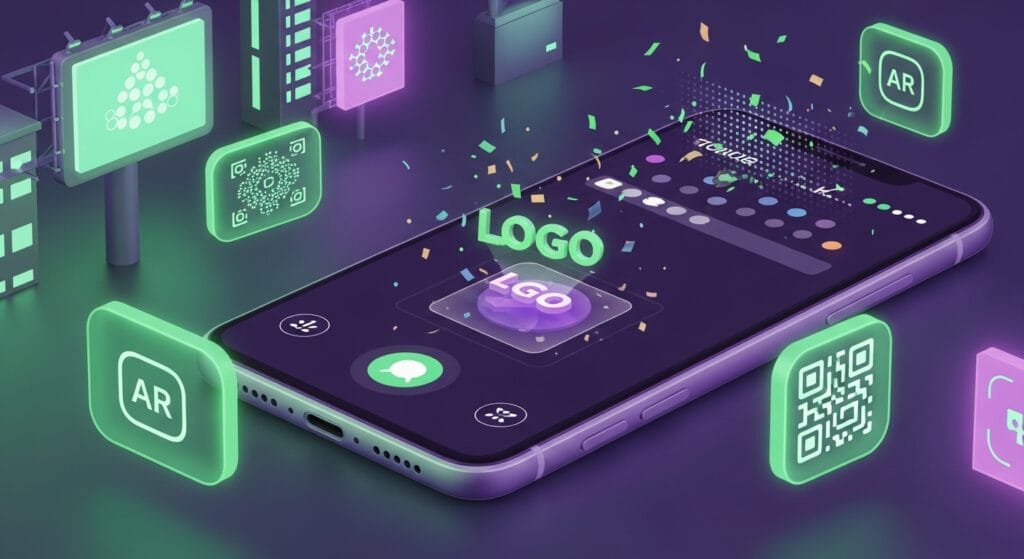
How to Start with AR Branding 2025
Implementing AR branding 2025 for small businesses can seem daunting, but a structured approach simplifies the process. Follow these steps to begin leveraging AR for your brand:
- Audit Brand Needs: Identify specific opportunities where AR can solve a problem or enhance customer experience. Do customers need to visualize products? Can AR make a product more interactive? This initial audit helps define your AR strategy.
- Choose Cost-Effective Tools: You don’t need a massive budget to start. Platforms like Spark AR (for Instagram/Facebook filters) and ARKit (for iOS app development) offer robust, cost-effective solutions (Codica). Consider web-based AR for broader accessibility.
- Develop AR Content: Create your AR filters, 3D models, or interactive scenes. User-friendly tools like Lens Studio (for Snapchat) or even 3D modeling software with AR export capabilities make this possible. Focus on high-quality, engaging content.
- Promote Your AR Experiences: Once your AR content is ready, promote it across your digital channels. Share your AR filters on social media. Feature AR try-ons prominently on your website. Optimize your promotional content for SEO using phrases like “how to use AR for branding 2025.”
- Monitor Performance: Track engagement with your AR content using analytics tools. Monitor app downloads, filter shares, time spent in AR experiences, and conversion rates. Google Analytics can help measure website engagement driven by AR. Use these insights to refine and improve your future AR strategies.
For businesses seeking expert guidance and accelerated results, partnering with a specialized agency is invaluable. Partner with SAQI Expert for tailored AR branding 2025 solutions that drive real success.
Conclusion
AR branding 2025 represents a powerful frontier for brand revolution. It allows businesses to drive 30% higher engagement and achieve 25% more conversions (Sprout Social).
From immersive virtual try-ons to engaging gamified campaigns, augmented reality branding strategies for 2025 offer small businesses a distinct competitive edge. This technology transforms passive viewers into active participants.
SAQI Expert’s expertise in developing and implementing these cutting-edge strategies ensures your success. Don’t miss out on this transformative opportunity. Contact us today to begin your journey and revolutionize your brand with AR.
About the Author:
Saqlain Riaz is the founder and lead WordPress developer at SAQI Expert, with over 5 years of experience in WordPress development and SEO. Based in Pakistan, Saqlain has built and optimized over 100 websites, helping small businesses boost visibility and conversions. His expertise spans web design, SEO, and digital marketing, with a passion for leveraging cutting-edge strategies to create user-friendly, high-performing sites. Saqlain’s client-focused approach has earned SAQI Expert a 4.9-star rating on TrustPilot. Connect with him on LinkedIn.







